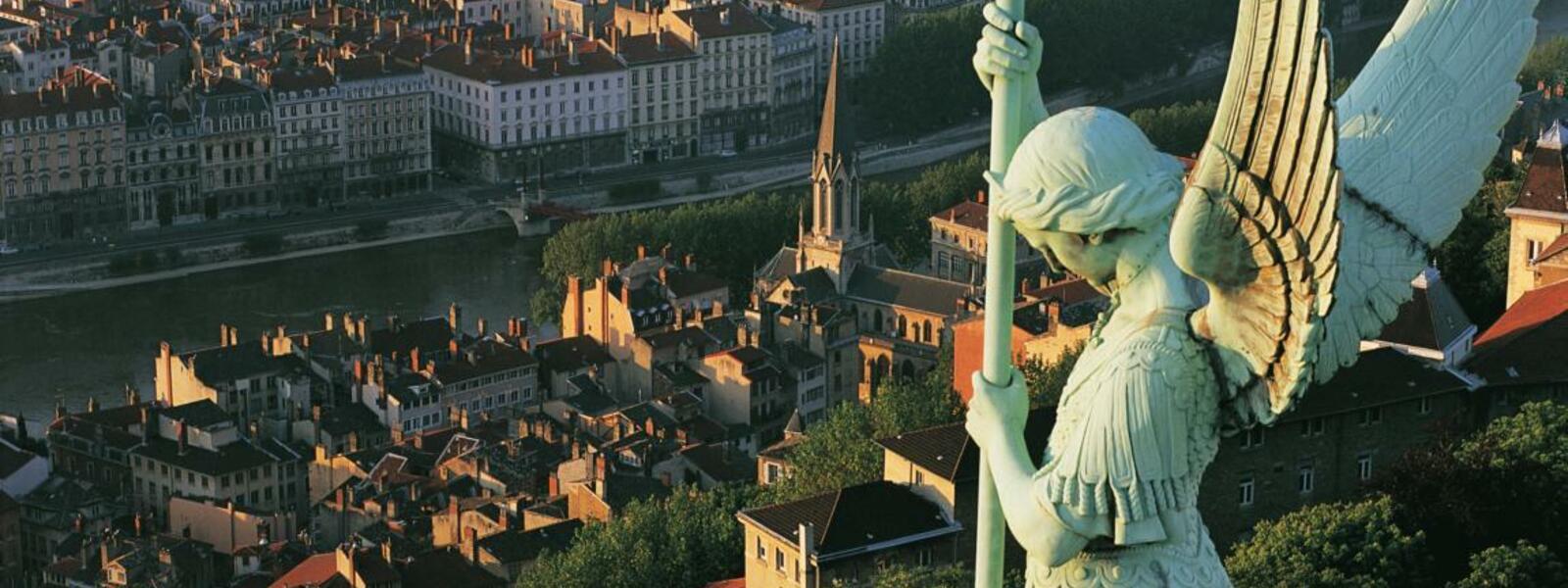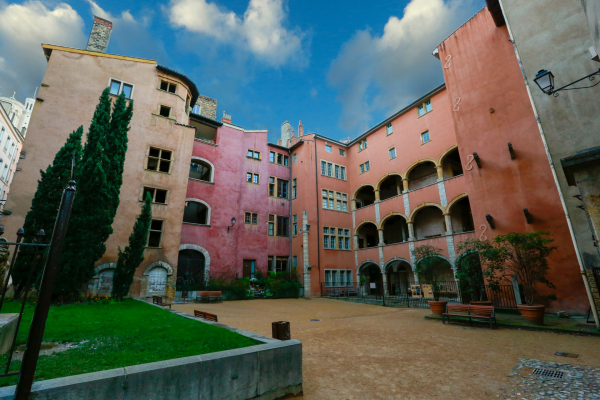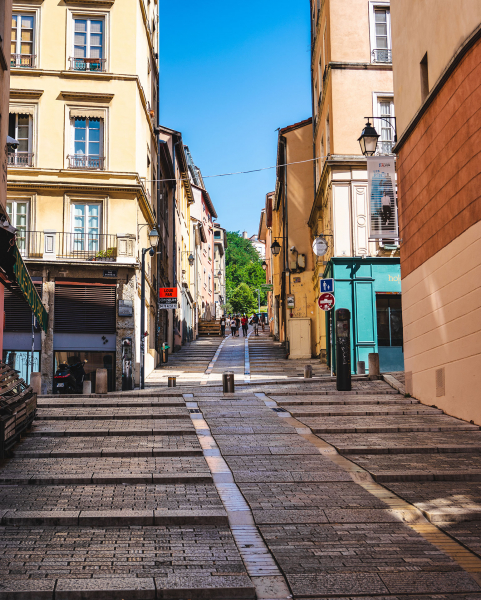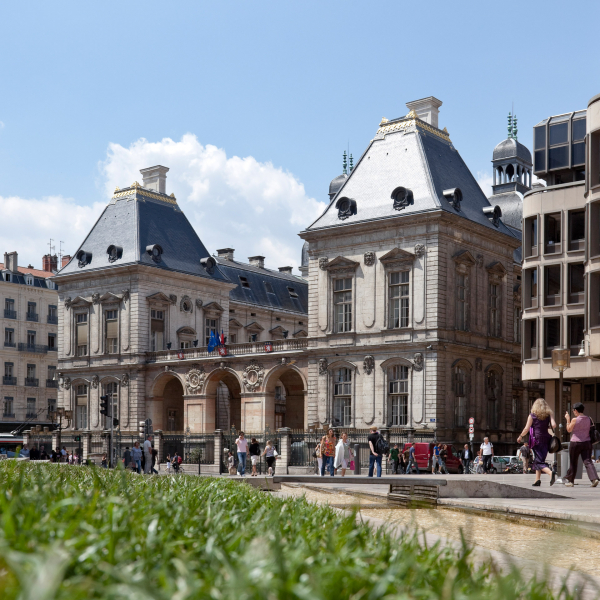Fourvière
Lyon’s oldest hill is home to the remains of Lugdunum, capital of the Gauls during the Roman Empire. Two ancient theatres recall Lyon’s earliest times: the grand theatre, built in 1 BCE, and extended in 1 CE, was dedicated to drama and could hold up to 10,000 spectators. The small theatre, known as the Odeon, built in 1 CE, was a venue for public readings and recitals. Next to the theatres, the Lugdunum Museum displays archaeological discoveries made in Lyon. You don’t need to dig for long before you find remains of the past in Lyon!
Fourvière Basilica, an iconic local landmark, built between 1872 and 1896 by Pierre Bossan, stands proudly on top of the hill. Stepping inside, visitors can discover the richness of its interior and the Byzantine influence in its gilded mosaics.
From Fourvière esplanade, with its stunning view over Lyon, a path leads down through Le Jardin du Rosaire, a haven of greenery.
Must-see sites on Fourvière Hill:
> Notre-Dame de Fourvière Basilica
> LUGDUNUM ancient Theatres and Museum
> Jardins du Rosaire, a garden on the side of the hill, beneath Fourvière Basilica
The Vieux-Lyon (Old Lyon) district
Between Fourvière Hill and the Saône, Vieux-Lyon (Old Lyon) has preserved all the charm of its narrow Renaissance streets.
Travel back to a time when Lyon hosted fairs that drew merchants from all over Europe to trade. Its fifteenth and sixteenth-century buildings were home to rich families of Italian, German and Flemish merchants and bankers.
Secretive and mysterious, Vieux-Lyon can be explored by stepping through doorways into its traboules (hidden passageways through buildings connecting streets) and inner courtyards, which reveal the wealth of their former owners.
While the buildings’ facades may seem simple, this is to better show off their decorations to visitors who venture through the doorways!
Around the Gothic Saint-Jean Cathedral, Rue Saint-Jean is lined with restaurants and shops. Along Rue du Bœuf, shops of creative designers stand alongside Michelin-starred restaurants.
Don’t hesitate to wander through the district’s narrow paved streets!
Must-see sites in Vieux-Lyon:
> Saint Jean Cathedral and its astronomical clock.
> Saint-Georges (19th century) and Saint-Paul churches (from 11th to 19th C.)
> Gadagne Museums: Musée d’Histoire de Lyon (historical museum of Lyon) and Musée des Arts de la Marionnette (puppet museum), in Lyon's largest Renaissance building.
> Cinema and Miniature Museum: with miniature models and Hollywood sets!
> Place de la Trinité for the charm, of its old buildings.
> Place du Change
> Courtyards and traboules (passageways): a free map showing the courtyards and traboules open to the public is available at the Tourist Office on Place Bellecour. Come and visit us!
La Croix-Rousse district
The second of Lyon’s hills presents visitors with an amazing sight, with its buildings standing in rows up the hillside. Since the nineteenth century, Croix-Rousse has been known among locals as ‘la colline qui travaille’ (the working hill), in contrast to Fourvière, ‘la colline qui prie’ (the praying hill). Home to the silk-workers of Lyon in the nineteenth century, the hill resounded with the sounds of the ‘Bistanclaques’, a local nickname given to the looms.
30,000 ‘canuts’ (as Lyon's silk-workers were known) made this an industrious district and helped Lyon become a major centre for textiles in Europe. Visitors are invited to explore this district to discover its spirit, with its buildings designed specially to house looms, traboule passageways and beautiful stairways. Les Pentes (the slopes of Croix-Rousse Hill) have a true neighbourhood community and village spirit that make their residents proud to be ‘croix-roussiens’.
Past and present live side-by-side, with tours of traditional silk-weaving workshops and shops of young creative designers who are keeping the canut spirit alive. Hermès still produces its famous silk scarves in the area surrounding Lyon!
Previously a working class district, Croix-Rousse is now a lively hub for artists and street art. As an important centre of Resistance during the Second World War, it has kept the rebellious spirit of the canuts alive!
Must-see sites on Croix-Rousse Hill:
> Silk-weaving workshops:
- La Maison des Canuts
- Soierie Vivante: Municipal weaving workshop and passementerie (decorative trimming) workshop.
- L’Atelier de Soierie
> Montée de la Grande Côte
> Roman ruins of l’Amphithéâtre des Trois-Gaules.
> Traboules and stairs: a free map showing the courtyards and traboules open to the public is available at the Tourist Office on Place Bellecour. Come and visit us!
> Place Bellevue : panoramic view of the left bank of the Rhône
> Jardin des Chartreux : view of the Saône and Fourvière
La Presqu’île district:
The beating heart of Lyon lies between the Rhône and Saône, where the city’s main shopping streets and luxury brand outlets can be found.
Urbanised for the first time during the Renaissance, the Presqu’île district has been expanded several times. Take a stroll along Rue Mercière to find the traces of its past and enjoy Lyon’s bustling nightlife!
The district experienced a major transformation in the nineteenth century. It runs from Place Bellecour, Europe’s largest pedestrian square, to Place des Terreaux, where the Hôtel de Ville (City Hall) and Musée des Beaux-arts (Museum of Fine Arts) stand. The nineteenth-century buildings reflect the affluence of Lyon’s bourgeoisie, while landmarks such as the Grand Hôtel-Dieu are fascinating architectural works to be discovered. When night falls, the district’s iconic fountains and monuments are illuminated, showing Lyon in a different light.
Theatres, cultural venues and restaurants make the Presqu’île a lively place to come in the evening, while, to the south, the Lyon of tomorrow is taking shape in the contemporary Confluence district…
Must-see sites in the Presqu’île district:
> Place des Terreaux : Town Hall and Musée des Beaux-arts (Museum of Fine arts)
> Opéra de Lyon (Lyon National Opera House)
> Mural of the famous Lyonnais: trompe l'oeil painted wall depicting local celebrities.
> Saint-Nizier Church, Gothic
> Shopping streets in the city centre: rues de la République and Edouard Herriot
> Passage de l’Argue : nineteenth-century covered passageway with old shops.
> Place and Théâtre des Célestins
> Fontaine Place des Jacobins
> Place Bellecour
> Le Grand Hôtel-Dieu
> St-Martin d’Ainay Basilica: Lyon's only Romanesque church.
The Tourist Office provides daily guided tours, in French and English, to explore the UNESCO site.
Further information on the guided tours in English
You can also rent audio-guides (French, English, Italian, Spanish and German) to discover Lyon at your own pace. Visit the Tourist Office on Place Bellecour (the building with flags), which opens every day from 9 am to 6 pm (closes on 25 December and 1 January).
Audiotours can also be downloaded on your smartphone. Further information
Lyon's UNESCO site: key facts
427 ha, or 10% of the city of Lyon, were listed as UNESCO World Heritage on 5 December 1998.
This includes the districts of Vieux-Lyon, Fourvière Hill, the slopes of Croix-Rousse Hill and much of the Presqu'île.
162 buildings are listed. 60,000 residents live on the site.
The remarkable urban continuity was recognised by UNESCO as an integral part of World Heritage.
Visitors can view 2000 years of history from the panoramic viewpoint on Fourvière Hill. From the 'forum vetus', which gave the hill its name, the city grew along the banks of the Saône and onto the Presqu'île, leading to the creation of the largest Renaissance district in France, before beginning its "conquest of the East" beyond the Rhône, from the eighteenth century onwards.





